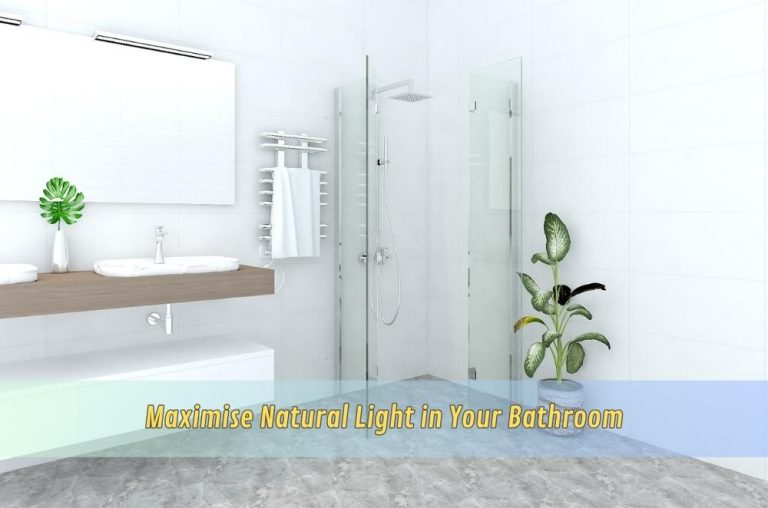Have you ever walked into a bathroom that felt more like a dungeon than a sanctuary? Even the most effortless routines can become a slog in a dark, cramped space. The issue usually is not the dimensions of the room but the absence of natural light. How do you maximise natural light in your bathroom?
Maximise natural light in your bathroom. By exploring aspects such as window placement, reflective surfaces, colour schemes and even the right features like premium shower screens that can help with the flow of light, you will read about the practical approaches to turn your bathroom into a bright and breezy experience.
Bringing light into the bathroom: Showering with nature
Daylight does wonders for a room. It costs nothing, boosts your mood, and makes spaces feel more prominent and welcoming. When you think about it, who wouldn’t choose a sun-drenched bathroom over a bat cave?
However, aside from the apparent advantages, natural light also plays a role in our overall well-being. It can better align sleep cycles, increase vitamin D levels, and improve productivity. As such, optimising natural light in your bathroom is desirable for physical aesthetics and promotes a more pleasant environment.
- Mood booster: Natural light has an observable and positive impact on mood; this boosts health and mitigates stress.
- Health benefits: Natural light exposure regulates circadian rhythms and promotes vitamin D production.
- Energy efficiency: By harnessing natural light, you decrease your dependence on artificial lighting, which translates to energy savings and reduced electricity bills.
- Improved beauty: A natural atmosphere promotes bright colours and a more welcoming environment.
- Open feel: Bright bathrooms with natural light tend to feel more prominent and open.
Banishing the darkness: How to strategically place your windows
Does light through windows are the most apparent natural light source, but placement is key. But just because you have a window doesn’t mean you’re getting the best of the sun — that’s because you need to have it facing the right direction to get in the most light in the middle of the day. Think about your bathroom’s direction and how the sun moves across those windows:
- South-facing windows tend to get the most direct sunlight, while north-facing windows deliver softer, more diffused light.
- Orientation matters: Southern Exposure windows provide the most sunlight, while northern exposure windows provide consistent, diffused light.
- Window size: Bigger windows let in more natural light to the bathroom.
- Privacy considerations: Identify the areas of the space that are more exposed to neighbouring structures or pathways. This could take the form of frosted glass or strategically placed blinds.
- Window style: Opt for window styles that allow the most light to penetrate, such as casement or awning windows.
- Placement height: You can place windows higher up on the wall, which will let in more light but also prevent passersby from seeing in;
Skylights and light tubes: That extra touch of ambience
Not only are windows sometimes not an option, but they are sometimes not enough. That’s where skylights and light tubes come into play. Skylights are an excellent way to fill upper-floor and windowless bathrooms with natural light. Light tubes (also called solar tubes) are a nifty solution for introducing daylight into windowless areas by transporting sunlight through a reflective tube.
- Skylights: Perfect for adding light to bathrooms on upper floors or with no exterior walls.
- Light tubes: Great for windowless bathrooms or areas without much light access.
- Diffused light: Skylights and light tubes can deliver gentler, more diffused light than direct sunlight coming through windows.
- Energy efficiency: Certain skylights and light tubes can be energy-efficient, reducing heat gain or loss.
- Skylights can provide unique design aspects to the bathroom.
Mirrors and tiles: that which reflect light
Once you have natural light in your bathroom, you can maximise it even further by adding reflective surfaces. Mirrors are an old favourite for bouncing light around the space and making the room feel lighter and more prominent. If you prefer the shiny side, glossy tiles, predominantly white or light-coloured tiles, will reflect the light and thus make the space feel as bright as possible.
- Architectural feature walls: Instead of painting all the walls, choose one wall to highlight with resistance colours.
- Tile finishes: Light glossy tiles work well to create the illusion of a larger space as they reflect light.
- Shiny accents: Use glossy accents to provide a sleek smoothness.
- Glass shower screens: Frameless shower screens, in particular, allow light to flow freely through the bathroom, improving its openness and brightness.
- Clutter Avoid: Use minimal decorative items on surfaces as much as possible to maximise the reflective properties of mirrors and tiles.
The power of light and dark tones: colour schemes
Bathroom colours significantly affect the way light plays in the space. Light colours like white, cream, and pastels reflect light and help make the room seem brighter and more significant. Darker shades absorb light and colour, making a room feel smaller and more enclosed. However, you don’t have to shy away from utilising darker colours in a small way—they create a great contrast and add visual interest to the overall space.
- Light colours: White, cream and pastels reflect light, making the room airy and bright.
- Dark colours: Darker colours can create contrast and interest but should not be used excessively in small bathrooms.
- Neutral palette: Go with a neutral colour palette, as it is a versatile backdrop that captures natural light and allows you to update with accessories quickly.
- Be aware of undertones: Consider the undertones of specific colours to ensure they work with the natural light in your bathroom.
- Paint samples: Test paint samples in your bathroom before committing to a colour scheme, as the exact shade will look different in various lighting conditions.
Conclusion: Maximising natural light
Making the most of natural light in your bathroom requires a holistic approach. It’s not just a matter of adding a window or two; it’s about thoughtfully integrating all aspects of the space, from where and what type of windows and materials to colour palettes and reflective surfaces. Use these tips to turn your bathroom into a bright, inviting, refreshing oasis.

